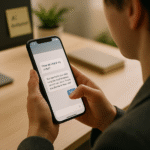Affordable Methods for Developing Mobile App MVP in 2025

Table of Contents
- What is a Mobile App MVP?
- Why Build a Mobile App MVP?
- Step-by-Step Process to Create a Winning Mobile App MVP
- Step 1: Define the Problem and Set Objectives
- Step 2: Research Market and Competitors
- Step 3: Determine Core Features and User Flow
- Step 4: Design UI/UX Prototypes
- Step 5: Choose the Tech Stack
- Step 6: Construct and Test the MVP
- Step 7: Launch and Collect Feedback
- Step 8: Iterate Based on Data
- Final Thoughts
- Get Started with MVP Center
Introduction
In today’s fast-paced digital world, creating a Mobile App MVP is a strategic way for startups to validate app ideas cost-effectively, reduce development costs, and launch quickly. This step-by-step guide to mobile app MVP development walks you through the process to build a successful MVP that meets user needs and gathers valuable feedback. At MVP Center, we specialize in helping startups transform ideas into scalable products.
What is a Mobile App MVP?
A Mobile App MVP (Minimum Viable Product) is a basic version of your app with only the essential features needed to solve a specific problem for early users. It allows you to test your concept, collect user feedback in MVP, and make data-driven decisions before full-scale development. For startups, understanding what is a mobile app MVP is key to launching a new app efficiently.
Tip: An MVP is the smallest product that delivers useful functionality, focusing on core features for MVP.
Why Build a Mobile App MVP?
Building a Mobile App MVP offers several benefits for startups:
- Faster Time to Market: Lean startup MVP principles accelerate your app launch.
- Lower Development Costs: Focus on must-have features to save on mobile app MVP cost.
- Validates Business Assumptions: Real user data confirms your app’s viability.
- Gathers Real User Feedback: Essential for iterative development for MVP and improvement.
- Attracts Investors: A working prototype showcases potential, aiding funding efforts.
Step-by-Step Process to Create a Winning Mobile App MVP
Follow this MVP app development process to ensure success:
Step 1: Define the Problem and Set Objectives for Mobile App MVP
The first step in developing a mobile app MVP is to clearly define the problem your app solves. Conduct market research for mobile app MVP, user interviews, and surveys to validate pain points.
Key Questions:
- What problem am I solving?
- Who are my target users?
- What do they expect?
Insight: Many MVPs fail by trying to do too much. Focus on one core issue, like Instagram’s initial photo-filtering feature.
Step 2: Research Market and Competitors for Your Mobile App MVP
Thorough market research for mobile app MVP identifies gaps and opportunities. Analyze competitors using tools like Google Trends or Sensor Tower.
Tasks:
- Research existing apps
- Identify underserved niches
- Review user feedback
Pro Tip: Craft a Unique Value Proposition (UVP) that addresses a specific market gap, e.g., “10-minute grocery delivery.”
Step 3: Determine Core Features and User Flow for Your MVP App
Prioritize features using the MoSCoW method for MVP (Must-Have, Should-Have, Could-Have, Won’t-Have). Map the user journey in MVP from first interaction to goal completion.
Deliverables:
- Feature priority list
- Wireframes or user flow diagrams
Clarity Tip: Include only core features for MVP that solve the main problem. One great feature trumps ten incomplete ones.
Step 4: Design UI/UX Prototypes for Mobile App MVP
Create prototypes using tools like Figma or Adobe XD. Focus on UI/UX design for MVP with usability and accessibility in mind.
Design Tips:
- Use established design patterns
- Prioritize responsiveness
- Leverage UI kits for speed
User-Centric Tip: Usability over aesthetics saves time and ensures a familiar experience.
Step 5: Choose the Perfect Tech Stack for Mobile App MVP Development
Select a tech stack for mobile app MVP that balances speed, scalability, and budget. Recommended options include:
| Componet | Options |
| Frontend | React Native, Flutter |
| Backend | Node.js, Firebase, Django |
| Database | MongoDB, PostgreSQL |
| Hosting | AWS, Heroku, Google Cloud |
Pro Tip: Choose tools for rapid development, avoiding over-engineering for MVP development.
Step 6: Construct and Test the Mobile App MVP
Build your MVP using agile development for MVP in short sprints. Prioritize functionality and use tools like Appium for MVP testing.
Focus Areas:
- Functionality over perfection
- Continuous integration (CI)
- Lightweight testing
Development Tip: Early feedback loops enhance efficiency in building a mobile app MVP.
Step 7: Launch and Collect Feedback for Your Mobile App MVP
Soft-launch your MVP to a limited audience. Collect user feedback in MVP using:
- In-app surveys
- App reviews
- Analytics tools like Mixpanel or Firebase
Trust Building Tip: Be transparent about the MVP stage to engage early adopters.
Step 8: Iterate Based on Data from Your Mobile App MVP
Analyze MVP metrics like user retention, feature engagement, and conversion rates. Apply the Build-Measure-Learn loop from the Lean Startup methodology.
Key Metrics:
- User retention
- Feature engagement
- Conversion rates
Iteration Tip: Be open to pivoting if data suggests a new direction, as seen in many successful apps.
Final Thoughts
Your Mobile App MVP is a launchpad, not the final product. By solving one problem efficiently, measuring key metrics, and iterating based on feedback, you lay a strong foundation for growth. This MVP app development guide ensures your app is lean, user-focused, and data-driven, attracting investors and satisfying users cost-effectively.
Get Started with MVP Center
Ready to build a mobile app MVP? Contact MVP Center for expert guidance on your MVP development journey. Start transforming your idea into a scalable product today!
Connect with MVP Center
Ready to take the first step towards unlocking opportunities, realizing goals, and embracing innovation? We're here and eager to connect.




